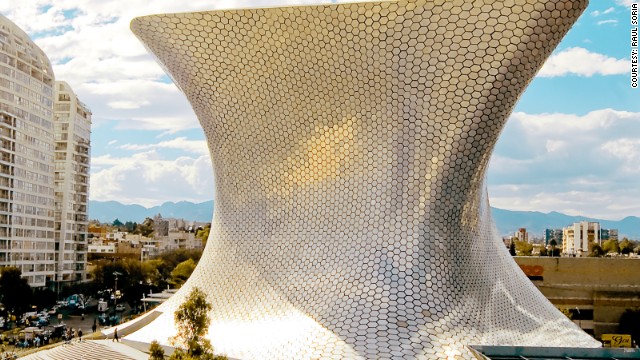Submitted by WA Contents
Do these buildings turn you on? The strange psychology of curvy architecture
United Kingdom Architecture News - Nov 27, 2013 - 11:13 9686 views

A feminine form
Zaha Hadid's design for the Qatar 2022 World Cup stadium attracted criticism for its resemblance to a certain part of the female anatomy. She says that it was inspired by the sail of a dhow, a traditional Arab fishing boat, but we leave it to you to decide.
From London's "Gherkin" to the "Marilyn Monroe" Towers in Ontario, when traveling through most of the world's major cities, you'd be forgiven for thinking that town planners had tried to baby-proof new buildings by imposing a strict ban on right-angles.
Indeed, if a flurry of new landmark building proposals are anything to go by, things are about to get a whole lot curvier.
Last week, Zaha Hadid unveiled her design for the 2022 World Cup soccer stadium in Qatar. Inspired by the dhow, a traditional Qatari fishing boat, its sensual roof curves and bends, like a free-flowing sail in the wind.
At the same time, the Cupertino city council gave Apple final approval for Apple Campus 2 - its massive new headquarters designed by starchitect Norman Foster. With an ultra-orbital shape and curving glass exterior, the building resembles a shimmering spaceship that has landed delicately in the fields of California.
And these are just two examples plucked from an ever-swelling list of proposed major structures with curling, sinuous and twisting features.
Nature vs nurture
It's tempting to think that this wave of wavy buildings merely reflects the dominant fashion of the age. But a growing body of research suggests that a strong preference for curvy shapes may in fact be hard-wired into the human brain.
Read: How David Hockney became the world's preeminent iPad artist
Psychologists have been toying with the idea that we respond to curves more positively than sharp lines for at least a century.
"Curves are in general felt to be more beautiful than straight lines," announced psychologist Kate Gordon in 1909. "They are more graceful and pliable, and avoid the harshness of some straight lines."
Now, more than a century later, a psychologist at the University of Toronto has put this conjecture to the test.
Oshin Vartanian and his colleagues slipped a group of people inside a brain-scanning machine and flashed hundreds of interior designs - some curvy, some angular - in front of them. They then had the choice of describing each room as either "beautiful" or "not beautiful."

But here's the really juicy bit: Vartanian's brain scans showed that curvy designs led to a burst of activity in the anterior cingulate cortex (ACC), a region of the brain known to contribute to emotional experiences - whereas rooms filled with sharp corners and perpendicular lines did not.

Others had a rectilinear form, like this//COURTESY OSHIN VARTANIAN
In other words, it looks like our brain circuitry comes pre-installed with an emotional attachment to rounded forms.
But why?
Paul Silvia, an assistant professor of psychology at the University of North Carolina at Greensboro, believes that a positive response to curves may spring from our relationship with natural environments.
Between vast rolling hills and gently contoured flower petals, right-angles are a rarity in the great-outdoors. "Curved buildings can point to nature, whereas angular buildings contrast with it," he says. "Instead of blending into the environment or evoking natural themes, they stand apart from it by using one of the few shapes you never see in nature—a perfect box."
Read: 50 years since pop culture's youth revolution
Silvia also points out that we're all born attuned to human faces. As anyone who's ever held a baby knows, their large round eyes frequently trigger uncontrollable feelings of warmth.
"Curved and rounded objects are so much more familiar that they seem more natural and 'right,'" he says.
On the other hand, sharp objects can appear decidedly wrong.Research from Harvard Medical School found that the amygdala, the brain's fear center, is significantly more active when people view angular objects, such as a sofa with sharp corners or a square watch, than when looking at curvier alternatives.
''Curved buildings can point to nature, whereas angular buildings contrast with it''
Paul Silvia, assistant professor of psychology
Rules of attraction
Hadid's soccer stadium in Qatar has been compared to a vagina, a description she has distanced herself from. But Stephen Bayley, a British architecture critic and the former chief executive of London's Design Museum, is convinced there is a sexual element in our response to curves.
"For reasons hidden in the foundations of the brain's architecture, a curve, because it suggests warmth and well-being and harmony, touches a more profound part of the psyche than a parallelogram," he says. "Maybe this is because a woman's breasts are generally not right-angled."
The instinct to appreciate curves may be hard-wired, but that doesn't mean architects will follow the instinct indefinitely. Fads tend to fall out of favor, only to re-emerge years later.
Bayley remembers how, several years ago, Norman Foster constructed an "unapologetically square building" for his London headquarters. A few years later he built a "wantonly curvaceous" residential building right next door. There is a clear lesson. "At this historic moment curves get a high approval rating," Bayley says. "But, as the rule of taste suggests, that will change again soon."

Superstar in the building

The Mothership

Mystique of human body

Fire dance

Man-made or nature-made?

Enchanting fans

From factory to fantasy

The temptress of Caucausus

The bridge with no end

Sea creature on land

Blurring the edges of water and earth

Metamorphoses of architecture

The marriage of contrasts

Art on the inside, art on the outside
> via CNN
